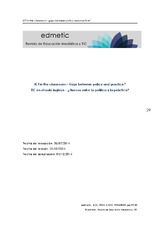Mostrar el registro sencillo del ítem
ICT in the classroom –Gaps between policy and practice?
| dc.contributor.author | Seeve-McKenna, Natalie | |
| dc.contributor.author | Whitaker, Rachel | |
| dc.contributor.author | Mckenna, Peter | |
| dc.date.accessioned | 2016-05-10T11:32:37Z | |
| dc.date.available | 2016-05-10T11:32:37Z | |
| dc.date.issued | 2015 | |
| dc.identifier.issn | 2254-0059 | |
| dc.identifier.uri | http://hdl.handle.net/10396/13510 | |
| dc.description.abstract | En el aprendizaje de las lenguas extranjeras, obligatorio para estudiantes de 8 a 14 años según el Currículo Nacional Inglés, la necesidad de integrar la tecnología en los métodos de enseñanza ha sido evidente: “las escuelas deberían utilizar una gran variedad de recursos, incluyendo TIC, para acceder a la información y comunicarse en la lengua meta” (Departamento de Educación, 2007). El estudio muestra los motivos por los cuales los profesores hacen uso de la tecnología así como su impacto en la motivacióndel alumno. Descubre también una clara tendencia de usar TIC para presentar el idioma en lugar de para promover un aprendizaje autónomo y personalizado. Los alumnos expresan una satisfacción subjetiva ante la tecnología utilizada en el aula de lenguas modernas así como el deseo de hacer uso de dicha tecnología de una forma más independiente. La tecnología gira, según este estudio a pequeña escala, alrededor de la figura del profesor, quien se encarga de su uso, y son escasos los ejemplos de las posibilidades comunicativas de naturaleza autónoma descritas previamente. Las conclusiones derivan de los cuestionarios realizados por 60 estudiantes y (sus) 2 profesores, así como de las conversaciones con los profesores de dos escuelas públicas inglesas. | es_ES |
| dc.description.abstract | In foreign language learning, required by the government's National Curriculum for children in England aged 8 to 14, the integration of technology into teaching methodologies has been explicit: “schools should use a range of resources, including ICT, (Information and Communication Technology) for accessing and communicating information in the target language" (Department for Education, 2007). This research investigates the role of ICT in language learning inside two English classrooms -a primary and a secondary –in order to explore the nature of motivation in educational technology from both the student and teacher perspective. The study elicits teachers' reasons for deploying the technology along with their emphases on the motivational advantages of ICT. It finds a marked tendency to use ICT for presentational, rather than autonomous or personalised learning. Children express subjective satisfaction with technology deployed in language learning and a desire to operate the technology more independently. The technology is, from this small scale study, teacher-led and teacher-driven, with few instances of the more autonomous communication possibilities outlined above (Department for Education, 2007). Field research findings derive from questionnaires of 60 pupils and (their) 2 teachers, as well as semi-structured interviews with teachers in two mainstream English school settings. | es_ES |
| dc.format.mimetype | application/pdf | es_ES |
| dc.language.iso | eng | es_ES |
| dc.publisher | Universidad de Córdoba, UCOPress | es_ES |
| dc.rights | https://creativecommons.org/licenses/by/3.0/ | es_ES |
| dc.source | Edmetic 4(2), 29-50 (2015) | es_ES |
| dc.subject | Motivación | es_ES |
| dc.subject | TIC | es_ES |
| dc.subject | Currículo nacional | es_ES |
| dc.subject | Aprendizaje de lenguas | es_ES |
| dc.subject | Motivation | es_ES |
| dc.subject | ICT | es_ES |
| dc.subject | National Curriculum | es_ES |
| dc.subject | Language learning | es_ES |
| dc.title | ICT in the classroom –Gaps between policy and practice? | es_ES |
| dc.title.alternative | TIC en el aula inglesa –¿huecos entre la política y la práctica? | es_ES |
| dc.type | info:eu-repo/semantics/article | es_ES |
| dc.relation.publisherversion | http://www.uco.es/ucopress/ojs/index.php/edmetic/index | es_ES |
| dc.rights.accessRights | info:eu-repo/semantics/openAccess | es_ES |

